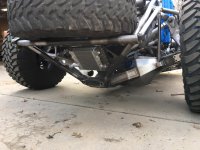Not sure who this IFS sorcerer is that you speak of but I think he has something figured out. First time I saw Scherer's new car I knew they had something going just by the looks of it in comparison to the other IFS portal cars. I'm a solid axle suspension junkie and have no clue about all the IFS geometry but this thing seems pretty wild.
Those that have more knowledge on it than me, what is the reason for the steep angle of the upper at ride height? Maybe a super low anti dive to allow the live valve to do all the work when braking and descending hills? Camber curve through travel? Or maybe it is just a result of how low this thing sits considering it being on portals. But I know none of the fun haver portal cars have this geometry. Seems like they really put some thought into designing a system specifically around the portals and live valve shocks. You could really see in qualifying how smooth this thing was in the small nuisance rocks in her problem and Idle issues in the second half of the course.
If you look closely at this diagram, you will visualize what happens with body roll. (You have to disregard the tires in the picture as they are wrong per the description of the geometry. I should fix that. but this is from Bob Boles who helps explain what is going on but misses it here. Which is fine with me because the casual observer will not get it.)
If all the arms were parallel and same length. The top of the tire would move significantly out (positive camber to the ground which is bad, especially in turning. Back when there was not so much offset in the wheels, the top arm could be shortened within the wheel or close to the rim, The top arm was shortened to pull the top of the wheel/tire in on body roll to keep the tire in better contact with the ground (like a SA). To make half shafts longer to save CV's on turning and articulation, the max wheel offsets have moved from 3.5" to in the 6" range. That meant the top "ball joint" had to move outside the tire. This makes the upright Huge/tall that was resisted in IFS design at first. But the designer always finds a way when it is clear that something needs to happen...or can now happen. Along with the old designs there has to be a certain separation between the top and bottom pivots at the frame for strength. As a result, the CAMBER GAIN (to the body but not to the ground) on body roll was limited. Now, you can almost go too far with it. If you look at Jason's picture, you can visualize that the top arm would really pull the top of the wheel inward on bump whee traction is most important. On droop, traction is less important because you have less pressure to the ground to make a huge difference. (And because of scuff actually makes some more contact...but just contact.
This gets compounding tricky when the inside pivots have to intersect the inner CV perfectly for bumpsteer, As well as King pin angle (KPI) and caster continues to come into play. This is where years of "experience" comes into play (FU's). Nope, not qualified to even say how. Just what it "should be."
Anti-dives and other IFS features are controlled by how much the top and bottom bulkhead has tilt to each other, and the pivot angles from the top view. These are closely held. Active shocks will make these angles less necessary but will help in keeping shock temperatures under control when the fluid in the shocks go restrictive and building more heat.
Personally, when I see a sway bar on a IFS, it is because they have missed the camber gain geometry and quick turning or cannot accept front body roll caster loss and slow tire grip turning. In the shop, they may still have articulation, but in video, they effectively don't.
Another picture is one that appeared on line where several commented on how bitchen it was. First was the photographer that didn't get it, and second the casual looker. It is a bitchen picture that does look fast though. But not. Before the Red Dragon rolled and they added a roll bar. Do the Mason designers get it? We learned from their 2wd's over the years and now they extend into 4wd with probably 4400 encouragement. To-date, they are sold out on trucks and will not build a 4400. I keep looking at the cool drivetrain stuff and question how bulletproof they would be at KOH. Time and experience will dictate that decision probably.
I can't believe this got boiled down to 5 paragraphs. But easier to discuss the why instead of how...........or how much.
Now look closer at the tire roll-under. That will also dictate how much caster gain you might want. Tire companies are making the carcuses stronger in the last couple years. This is where the video and stills tell the story. Not on the drawing board. CAD and simulation is useless with out that mental and visual input. Now look at some SXS pictures, where, by "rule" the pivots can't be changed from stock. And, I think most of the new rigs are/will be going narrower as geometry has allowed. And all of this can be changed with purpose-full set-ups. (Qual vs Race) So you DO have to be careful when looking. A whole bunch can be exaggerated for short term..




